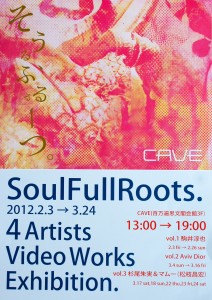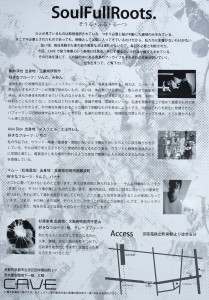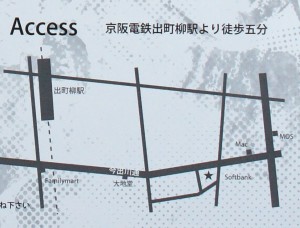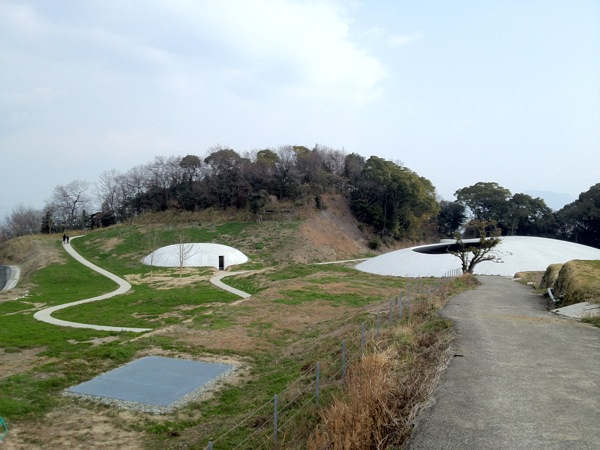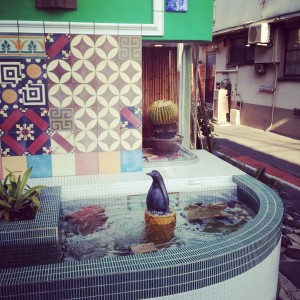Students from Kyoto University of Art and Design (京都造形芸術大学) are holding an exhibition of video art in a dis-used office just east of Hyakumanben, on the south side of Imadegawa street. If you are interested in video art, it is well worth going to have a look. The exhibition will be open again next week (金土日). Check the flier above for details. Here’s the access map.
Monthly Archives: March 2012
Ends today in Paris …
This exhibition, which ends today in Paris, includes works by Hiroshi Sugimoto, Tadanori Yokoo, Takeshi Kitano, David Lynch, Patti Smith, and others. The exhibition was created through a dialogue between the artists and practicing mathematicians. I love the byline, a quote by Alexandre Grothendieck, that mathematics offers a “a sudden change of scenery.”
The Fondation Cartier created an iPad app to introduce the exhibition and it is available free in the iTunes store.
Teshima Art Museum – 豊島美術館

The Teshima Art Museum opened in 2011. The center piece of this outdoor ‘museum’ is a concrete thin-shell structure by artist Rei Naito and architect Ryue Nishizawa. Two oval openings in the roof let pass the sounds of the trees, birds, the wind, and the nearby Inland Sea. Water seeps slowly through many tiny holes in the floor, aggregates into drops of various sizes then snakes towards the lowest local point, where it empties again into the tiny holes. Visitors wander the strangely shaped, barren space, a singular environment that selectively amplifies sounds inside and outside the shell. Gradually attention is drawn towards the drama of surface tension and energy minimization being played upon the floor. Watching the surprisingly complex dynamic shapes of the water drops suggests fantasies about the origins of life on earth. The remarkable and somewhat mysterious physical properties of water must be part of what led living matter to get a start on the planet. The shell provides a shelter for quiet and focused meditation on the sounds of the surrounding natural environment and the movements of water on the smooth subtly shaped concrete. Late 20th century technology, in the form of the thin concrete shell, initially visually impressive both outside and inside, gradually slips into the background.
From the museum home page:
Uniting the creative visions of artist Rei Naito and architect Ryue Nishizawa, Teshima Art Museum stands on a hill on the island of Teshima overlooking the Inland Sea. Shaped like a drop of water, the museum lies in a corner of the spacious grounds surrounded by once-fallow rice terraces that have been restored with help from local residents.
Structurally, the building consists of a concrete shell, devoid of pillars, coving a space 40 by 60 meters. On the highest ceiling 4.5 meters above, two oval openings allow the air, sounds, and light of the world outside into this organic space where nature and architecture seem intimately interconnected. Inside one finds an ever-flowing fountains and an ambiance that changes from hour to hour and season to season, revealing countless appearances as time passes.
「直島銭湯 I♥湯」I♥ユー
The artist who created this unique and delightful sento Shinro Ohtake (大竹伸朗), must have known I was coming, because just as I entered the hot water, Fripp & Eno‘s 1975 ambient album Evening Star began to play. It was impossible for me to leave without listening to the entire 45 minute album. Needless to say, I had a good long soak.
You can listen to track 2, on YouTube. Try it in the bath.
Thinking Out Loud in Naoshima
I’m spending a couple of days in Naoshima recovering from several weeks of publication and reviewing deadlines, administrative duties, and too many long meetings.
No photos allowed inside the splendid contemporary art museums here, so instead I’ve tested the inadequacy of (my) words by recording some spontaneous thoughts while viewing artworks. The following unedited 25 minute ramble is completely off the top and in all likelihood boring or ridiculous.
The First NIME
The BBC News web site currently has a good article about the Theremin, an electronic instrument invented by Russian Léon Theremin in 1919. Though it was not the first synthesizer, I consider the Theremin to have been the first NIME: earlier electronic synthesizers like the Telharmonium (1897) mainly used keyboard-like controllers. The Theremin, by contrast, is played with non-contact gestures (waving your hands in the air). It is a full blown new electronic instrument, the product of a futurist/modernist outlook and cutting-edge technical mastery (for the day), which opened the potential for completely new forms of human artistic expression.
I am not going to introduce the Theremin here. Better to start by reading the BBC article or Wikipedia entry, both linked above. You can get an idea of how it can be played by watching any number of videos on YouTube. Here’s Léon Theremin’s neice, Lydia Kavina, playing Claude Debussy’s “Clair de Lune”:
The BBC article quotes an interesting statement from Theremin biographer Albert Glinsky which I would like to include here:
RCA felt this was going to replace the parlour piano and anyone who could wave their hands in the air or whistle a tune could make music in their home with this device. The Theremin went on sale in September 1929 at the relatively high price of $220 – a radio set cost about $30. It was also much more difficult to play than the advertising claimed. And just one month later came the Wall Street Crash. You took it home and found that your best efforts led to squealing and moaning sounds. So the combination of the fact that only the most skilled people could teach themselves how to play it and the fact that there was a downturn in the economy meant that the instrument really wasn’t a commercial success
This seems to be a somewhat common story with the most unusual/innovative new music technology – it is difficult to get make significant cultural impact.

The Theremin, however, has had good staying power. It is still a niche instrument with few virtuosi, but you can, in fact, purchase a Theremin and find someone to help you to learn how to make music with it. High quality Theremins are made by Moog Music. As it turns out, electronic instrument pioneer Robert Moog got started by selling Theremin kits while he was still an undergraduate physics student. Moog represents an important link between the earliest NIMEs and contemporary electronic music technology and culture. For this reason we invited Dr. Moog as a Keynote speaker for NIME-04, which was held in Hamamatsu, Japan’s mecca for music technology.
I had the good fortune to invite Dr. Moog to give a talk at the company where I used to work, ATR, in southern Kyoto prefecture. It was a great experience to spend time talking with Dr. Moog and to introduce him to a huge and enthusiastic audience who showed up from all over Japan to hear him speak. I will never forget what a kind-hearted person Bob Moog was.
Joseph Beuys in Ubud, Bali
It has been seven years since I was on the magical island of Bali. So magical that I managed to capture the voice of Joseph Beuys while doing some field recordings in the rice paddies surrounding Ubud:
(A note of thanks to Ableton, Leonardo of Pisa (aka Fibonacci) and, not least, Ubudweb.
Galileo on the Role of Mathematics in Science
A quote from Galileo Galilei‘s book, Il Saggiatore published in Rome, October, 1623:
Philosophy [i.e. physics] is written in this grand book — I mean the universe — which stands continually open to our gaze, but it cannot be understood unless one first learns to comprehend the language and interpret the characters in which it is written. It is written in the language of mathematics, and its characters are triangles, circles, and other geometrical figures, without which it is humanly impossible to understand a single word of it; without these, one is wandering around in a dark labyrinth.
The same can be said of media arts and sciences: if you aim to go beyond a superficial understanding of contemporary media technology, it is necessary to be able read the language in which it is based. Ultimately, that language is mathematics.
In my first year of graduate school, there was a student from Greece who taped a banner above the entrance to the graduate student offices. His banner looked something like this:

meaning ‘Let no one ignorant of geometry enter here‘, an inscription that is said to have hung over the entrance to Plato’s academy. The importance of mathematics for understanding the world was recognized in ancient times by the Greek philosophers, reflected in the painting by Renaissance artist Raphael, The School of Athens, linked above. One sometimes sees reproduction of Raphael’s painting displayed in research labs and scientist’s offices. I have one which I bought as a souvenir on a visit to the Vatican.
While mathematics is often deeply hidden behind the user-friendly interfaces of the complex software packages we use in our work, it is important to understand it is basis for these tools. Especially in the area of computer graphics, no development of new techniques is possible without an understanding of geometry and other branches of mathematics. If you are doubtful, try sitting in on some presentations at a graphics conference such as ACM Siggraph. Without some knowledge of mathematics you will quickly come to feel that you are wandering in a dark labyrinth.
[1] Galileo Galilei, Il Saggiatore, Rome, 1623.
Quote via the Wikipedia article about the English translation, The Assayer.
kuniko plays reich in kyoto
I’m really looking forward to this concert. What a cool poster!!! It has two holes in the shape of marimba mallets.
On the program:
- Steve Reich – Electric counterpoint (version for percussion)
- Steve Reich – Six marimbas counterpoint
- Steve Reich – Vermont counterpoint (version for vibraphone)
- Iannis Xenakis – Rebonds (a,b)
More info. about composer Steve Reich is available at his official web site. You can also have a look at the Wikipedia (English, 日本語). Similarly, you might like to read up about Iannis Xenakis at the Wikipedia (English, 日本語) as well as the official Xenakis site in French and English.
Here are the details about the concert from the web page of the Kyoto Art Center:
会場:講堂
構成・出演:加藤訓子(パーカッショニスト)
音響空間デザイン:深田晃
料金:一般前売1,800円/当日2,000円、大学生以下1,000円(前売・当日共)
チケット取扱:京都芸術センター窓口<10:00-20:00>、チケットぴあ(Pコード:160-836)にて発売中
※本ウェブサイト左上の「このイベントを申し込む」からも予約可。大学生以下券をお求めの場合は、備考欄に「学生」とご記入ください。
※就学前児童の入場はご遠慮ください。
Vimeo & YouTube HD Informal Comparison
I uploaded the same HD video file (1280×720 progressive) to YouTube and Vimeo. Watch these on full screen, with resolution set to 720p on YouTube and ‘HD Mode’ selected on Vimeo.
Simple P5 Sketch Circle Animation (720p) from Michael Lyons on Vimeo.
This is an unusual video in that it consists only of moving black lines on a pure white background, so compression artifacts are quite noticeable. The raw data (1800 png image files) is over 200MB but artefacts were barely visible in the ~100MB H.264-compressed mp4 file I uploaded to both Vimeo and YouTube. That noted, it seems clear that YouTube has the advantage in terms of quality. Since I’ve read otherwise in informal reports on the web, I’m not sure whether or not the quality might improve with Vimeo Plus, a paid upgrade currently available for the discounted price of US$60/year. Overall, Vimeo offers a calmer, more pleasant user experience than YouTube. The user interface is nicely designed and the online help files are easy to navigate and genuinely helpful. The content and the community are generally more edifying: no denying it there’s a lot of trash on YouTube. The advertising on YouTube is also more obtrusive and distracting. As for pure spec: time to upload and process a video is much quicker with YouTube. Upload is slower with Vimeo and they also make non-paying users wait for at least 30 minutes before the video goes online. Moreover there are weekly limits on total data and only one HD video may be uploaded per week. Third party advertising is less intrusive but lately Vimeo is pushing the paid-subscription fairly hard.
Addendum: Vimeo offers a slightly better experience when browsing from iOS devices in that it’s easier to directly open the 720p viewer. But compression artefacts are still more noticeable, with this file, than with YouTube. Note also that YouTube allows upload of higher resolution videos such as ‘Full HD’ (1080p).

